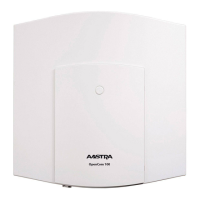Configuration Examples
97
ternet connection. For this reason, you should choose a name which is not used in
the Internet as the domain name (“firm-opencom.co.uk” for example).
RAS Access
You can establish a connection to the OpenCom 100 from an external PC via an ISDN
card.
The necessary IP settings are transmitted by the OpenCom 100 on establishment of
the connection. The computer that has dialled in has access to all services in the LAN
that can be used via the IP protocol. The authorisation for RAS access is set up in the
Configurator via the User Manager: User Groups menu.
The technical properties of the connection can be configured in the Configurator via
the Network: RAS menu. Further information can be found in the online help of the
web console.
In a serverless LAN, Windows uses the NetBIOS protocol for accessing files and
printers via the network environment. NetBIOS can use NetBEUI, IPX/SPX or IP as the
transport protocol. In the network environment, you can only access files and printers
on workstations using IP for NetBIOS.
OpenCom 100 in a LAN with an IP-enabled Server
In a LAN with an IP-enabled server, you should coordinate integration of the
OpenCom 100 with the responsible network administrator. You must decide on the IP
address space to be used and which network services (DHCP, DNS, RAS, Internet
access) the OpenCom 100 is to handle in the LAN.
In many cases, an IP-enabled server configures the IP settings via DHCP for all work-
stations. In networks in which the IP settings are made manually, you have to enter
the corresponding IP settings in the OpenCom 100 Configurator (Network: LAN
menu). Additionally you should change the DHCP server to static address assignment
(in the Network: DHCP menu) to enable the OpenCom 100, for example to configure
connected VoIP system telephones. In certain cases you have to restrict the DHCP
function of the IP-enabled server to ignore the MAC addresses for such terminals.

